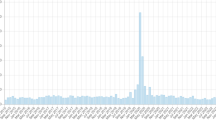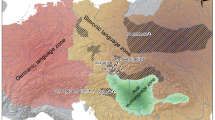Abstract
Heng Xian is a previously unknown text reconstructed by Chinese scholars out of a group of more than 1,200 inscribed bamboo strips purchased by the Shanghai Museum on the Hong Kong antiquities market in 1994. The strips have all been assigned an approximate date of 300 B.C.E., and Heng Xian allegedly consists of thirteen of them, but each proposed arrangement of the strips is marred by unlikely textual transitions. The most plausible hypothesis is one that Chinese scholars do not appear to take seriously: that we are missing one or more strips. The paper concludes with a discussion of the hazards of studying unprovenanced artifacts that have appeared during China’s recent looting spree. I believe the time has come for scholars to ask themselves whether their work indirectly abets this destruction of knowledge.
Similar content being viewed by others
References
Allan, Sarah, and Crispin Williams, eds. 2000. The Guodian Laozi: Proceedings of the International Conference, Dartmouth College, May 1998. Early China Special Monograph Series 5. Berkeley, Calif.
Anonymous. 2010. Brief Report on the Work of the Institute for the Study of Excavated Documents, Beijing University 北京大學出土文獻研究所工作簡報. 2010.3. Informally distributed.
Appiah, Kwame Anthony. 2006. Cosmopolitanism: Ethics in a World of Strangers. Issues of Our Time. New York: W.W. Norton.
Bunker, Emma C. 2005. “The Acquisition and Ownership of Antiquities in Today’s Age of Transition.” Who Owns the Past?: Cultural Policy, Cultural Property, and the Law. Ed. Kate Fitz Gibbon. New Brunswick, N.J., and London: Rutgers University Press. 311–17.
Cao, Feng 曹峰. 2006. Studies on the Philosophy of the Chu Strips from the Shanghai Museum 上博楚簡思想研究. Chutu Wenxian YizhuYanxi Congshu P025. Taipei: Wanjuanlou.
Chao, Yuen Ren. 1968. A Grammar of Spoken Chinese. Berkeley and Los Angeles: University of California Press.
Chase, Arlen F., et al. 1988. “Archaeology and the Ethics of Collecting.” Archaeology 41.1: 56–60, 87.
Chen, Songchang 陳松長. 2001. Bamboo and Wood Manuscripts Housed in the Art Museum of the Chinese University of Hong Kong 香港中文大學文物舘藏簡牘. Xianggang Zhongwen Daxue Wenwuguan Cangpin Zhuankan 7. Hong Kong: Art Museum, Chinese University of Hong Kong.
Coggins, Clemency. 1972. “Archaeology and the Art Market.” Science 175: 263–66.
Cuno, James. 2008. Who Owns Antiquity? Museums and the Battle over Our Ancient Heritage. Princeton and Oxford: Princeton University Press.
Dutra, Michael L. 2004. “Sir, How Much Is That Ming Vase in the Window? Protecting Cultural Relics in the People’s Republic of China.” Asian-Pacific Law and Policy Journal 5: 62–100.
Elia, Ricardo J. 1993. “A Seductive and Troubling Work.” Archaeology 46.1: 64, 66–69.
Elman, Benjamin A. 2000. A Cultural History of Civil Examinations in Late Imperial China. Berkeley: University of California Press.
Felch, Jason, and Ralph Frammolino. 2011. Chasing Aphrodite: The Hunt for Looted Antiquities at the World’s Richest Museum. Boston: Houghton Mifflin Harcourt.
Fiskesjö, Magnus. 2009. “The Politics of Cultural Heritage.” Reclaiming Chinese Society: The New Social Activism. Ed. You-tien Hsing and Ching Kwan Lee. Asia’s Transformations. New York: Routledge. 225–45.
He, Shuzhong. 2001. “Illicit Excavation in Contemporary China.” Trade in Illicit Antiquities: The Destruction of the World’s Archaeological Heritage. Ed. Neil Brodie et al. McDonald Institute Monographs. Cambridge. 19–24.
Ji, Xusheng 季旭昇. 2005. Bamboo Manuscripts from the Warring State of Chu Housed in the Shanghai Museum, Vol. III: A Reader《上海博物館藏戰國楚竹書(三)》讀本. Chutu Wenxian Yzhu Yanxi Congshu 22. Taipei: Wanjuanlou.
Jingmen Municipal Museum 荊門市博物館. 1998. Bamboo Strips from the Chu Tomb at Guodian 郭店楚墓竹簡. Beijing: Wenwu.
Li, Ling 李零. 2003. “Gengxian” 亙先. Bamboo Manuscripts from the Warring State of Chu Housed in the Shanghai Museum 上海博物館藏戰國楚竹書, Vol. III. Ed. Ma Chengyuan 馬承源. Shanghai: Guji. 287–99.
Li, Rui 李銳. 2010. Scholarly Investigations on Recently Excavated Bamboo and Silk Manuscripts 新出簡帛的學術探索. Beijing Shifan Daxue Shixue Tansuo Congshu. Beijing.
Li, Xueqin 李學勤, ed. 2011. Bamboo Strips from the Warring States Housed at Tsinghua University 清華大學藏戰國竹簡. Multiple vols. projected. Shanghai: Baijia.
Ma, Chengyuan 馬承源. 2001. “Foreword: The Discovery, Preservation, and Editing of the Bamboo Manuscripts from the Warring State of Chu 前言:戰國楚竹書的發現保護和整理.” Bamboo Manuscripts from the Warring State of Chu Housed in the Shanghai Museum 上海博物館藏戰國楚竹書, Vol. I. Ed. Ma Chengyuan. Shanghai: Guji. 1–4.
Mackenzie, Simon. 2011. “Trafficking Antiquities.” International Crime and Justice. Ed. Mangai Natarajan. Cambridge: Cambridge University Press. 141–47.
Merryman, John Henry. 2004. “A Licit International Trade in Cultural Objects.” Art Market Matters. Helvoirt, Netherlands: European Fine Art Foundation. 13–36.
Pang, Pu 龐朴. 2004. “A Tentative Reading of Heng Xian” 《恆先》試讀. Bulletin for Research in Ancient Chinese Intellectual History 中國古代思想史研究通訊 2: 21–23.
Pulleyblank, Edwin G. 1995. Outline of Classical Chinese Grammar. Vancouver: UBC Press.
Renfrew, Colin. 2000. Loot, Legitimacy and Ownership. Duckworth Debates in Archaeology. London.
Richter, Matthias. 2005. “Introduction.” Asiatische Studien 59.1: 5–9.
Schuessler, Axel. 2007. ABC Etymological Dictionary of Old Chinese. ABC Chinese Dictionary Series. Honolulu: University of Hawaii Press.
Shaughnessy, Edward L. 2006. Rewriting Early Chinese Texts. SUNY Series in Chinese Philosophy and Culture. Albany: State University of New York Press.
Society for American Archaeology. 1996. “Society for American Archaeology Principles of Archaeological Ethics.” American Antiquity 61.3: 451–52.
Wang, Zhongjiang 王中江. 2008. “The Structure of the View of the Cosmos and of the Human World in Heng Xian”《恆先》宇宙觀及人間觀的構造. Literature, History, Philosophy 文史哲 2008.2: 45–56.
Winter, Irene J. 2008. Review of James Cuno, Who Owns Antiquity?. Art Bulletin 91.4: 522–26.
Xing, Wen 邢文. 2010a. “A Transcription of the Chu Bamboo-Strip Heng Xian, with Section Divisions” 楚簡《恆先》釋文分章. History of Chinese Philosophy 中國哲學史 2010.2: 51–56.
_____. 2010b. “The Chu Bamboo-Strip Heng Xian and the ‘Eight-Legged Essay’” 楚簡《恆先》與“八股文.” Guangming Daily 光明日報 (March 1, 2010).
Zhu, Hanmin 朱漢民 and Chen Songchang 陳松長, ed. 2010. Bamboo Strips from Qin Housed at the Yuelu Academy 嶽麓書院藏秦簡. Multiple vols. projected. Shanghai: Cishu.
Author information
Authors and Affiliations
Corresponding author
Rights and permissions
About this article
Cite this article
Goldin, P.R. Heng Xian and the Problem of Studying Looted Artifacts. Dao 12, 153–160 (2013). https://doi.org/10.1007/s11712-013-9323-4
Published:
Issue Date:
DOI: https://doi.org/10.1007/s11712-013-9323-4




